 Image courtesy of stockimages at FreeDigitalPhotos.ne Image courtesy of stockimages at FreeDigitalPhotos.ne Many are looking to grow their construction companies. To do this you need additional people, equipment, and of course projects. Sometimes the simple solution seems to purchase another construction company and merge it into your company. But is this a good solution? Well, it depends. I worked for a construction company which was privately owned and almost a family business when I joined them. Within twenty years the company had grown into a multinational public company with revenue of several billion dollars and profits of a hundred plus million dollars. This growth was achieved by a combination of growing the company from within, as well as purchasing other construction companies. However, not all these purchases were successful, and a few even proved very costly. But, some of these purchases provided the company with the right resources and clients to grow, as well as giving us a springboard into other markets and regions. In this growth, our company became a takeover target for another construction company, which fortunately we resisted and we eventually outstripped the size of that company and became far more successful. So what did we learn from these takeovers, mergers, and acquisitions? Why are you purchasing the company? Are you sure it’s a cost-effective solution?It’s important to carefully analyze the reasons for purchasing another construction company. Only purchase a company if it’s going to offer additional opportunities and add to the balance sheet of your company. These opportunities may be because the new company:
Proper investigation is essential before purchasing a construction companyIt’s imperative that a proper due diligence is carried out on the new company before purchasing it. This should include reviewing:
Conclusion...Continue Reading.... This article was first published on the ClockShark website. To visit this website and continue reading the article click on the link above. Please share this post  To read more about the author’s books and find out where you can purchase them visit the pages on this website by clicking the links below:
To read more about the author visit the page 'Paul Netscher' Want to contact Paul Netscher please enter your details on 'Contacts' Find out how Paul Netscher can help you
0 Comments
Why do some construction companies grow successfully and others stumble?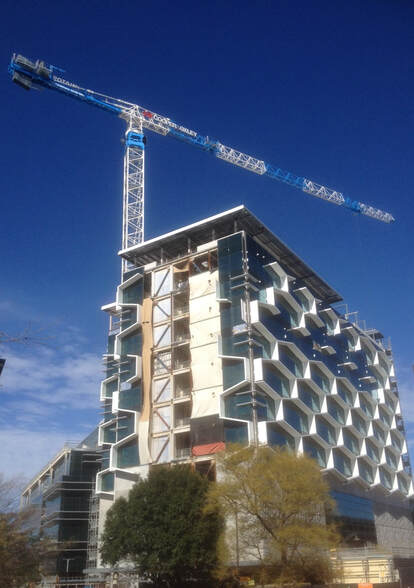 I’m sure we have all heard of construction companies that have expanded, become successful, revenue has increased and their profits have increased, then, the wheels have come off. Profits have fallen and share prices collapse! Some companies even go bankrupt. Where did it all go wrong? Of course, we all know of the small local builder who kind of ‘bobs along’. They employ only a handful of people, making an average profit most years and every now and then striking it lucky with a really good year. The owner seems content. But then they have a bad year, literally living from hand to mouth struggling to pay their bills, surviving until another good project comes along. Is that what you want to be? Yet, occasionally we have construction companies that have grown within a generation, from a one-man business to a multi-million-dollar construction empire, that often spans many states and may even have grown into a multinational organisation constructing mega projects in other countries. The company is now worth tens or hundreds of millions of dollars, occasionally even worth a billion dollars. Maybe that’s what you would like your construction company to be? So it is possible to stay small and successful and is it also possible to grow and become successful. So how do you decide what direction your company should follow, and how do you make those decisions successful? Of course, there are also many companies somewhere in between, which are growing at a steady pace, maybe even with a few contractions when work dries up, then growing again when there’re more opportunities. The one-man company possibly now has a hundred employees and there’s a steady stream of projects. lick here to edit. Why construction companies should growGrowing a company successfully is very satisfying. It enables the original owner to move away from being hands-on where they were possibly working in the field on the project all day, while trying to complete paperwork at night and on weekends. It allows the original owner to take management control while relinquishing some of the smaller day-to-day project management duties. It’s often less physically demanding. It allows the owner to take on other bigger responsibilities and learn new skills. Of course, it also creates new opportunities for employees, who can grow into new roles and take on new responsibilities while learning new skills. Not many people are happy fulfilling the same functions and jobs forever – most of us want to grow and develop. As the company grows, the employees grow, and in doing so employees earn more and can better their lives and the lives of their families. Of course, a larger company can take on more projects and work with different clients which allows them to diversify so the company isn’t solely dependent on the success of their current projects. Sure there will be some projects that aren’t profitable and the amount of work in some areas will decline for a period, but having a diversified portfolio of projects and clients, preferably covering a number of different regions, will enable the company to better survive the occasional poorly performing project and the unpredictability of the construction industry. In fact, being bigger will mean that the company executes larger projects that could extend over a period of a couple of years, which might enable the company to get through the lean times easier. Being the owner of a small company is often a lonely job where you alone must make all the decisions, where you alone must solve the problems. Larger companies usually have experienced and skilled people that can shoulder some of the responsibilities, handle the day-to-day problems on projects, and who can provide advice for solving the more difficult problems. A successful and well-managed construction company provides employment opportunities for many workers – sometimes hundreds or even thousands. Of course, a successful growing construction company can make the original owner very wealthy. As the company grows it will take on projects in other regions which may bring opportunities to set-up house in another area which may be more suitable for the family. A larger company means that you can take on larger projects and more challenging projects. At the end of the day building a successful large construction company creates a legacy that others will appreciate, a legacy that’s changed employees’ lives for the better. Why some construction companies failMany construction companies start off successfully. They develop a good reputation and are profitable. The company grows. Then the cracks appear. Quality deteriorates. Projects are no longer profitable. The company starts losing money. Why does this happen? Well, there are a number of reasons.
Controlled growth It’s imperative that the company grows in a controlled manner. The owner must gradually hand over control of various areas of the business to trusted, experienced individuals. The company must progressively increase the number and size of the projects they undertake, ensuring that they always have sufficient cash to finance their operations (including maintaining a buffer for when the unexpected happens) and sufficient resources to carry out the work. Growing a construction company requires good people and robust systems that can handle the growth and simplify the workload. Managing a large construction company is very different to running a small company. But, it must never be growth at any cost. Some business owners and managers are driven to grow the business no matter what the conditions are. Large companies have shareholders who expect the company revenue to increase every year, particularly after the company has experienced a few years of stellar growth. Unfortunately, construction has periods of growth and times when work is in short supply. It’s inadvisable to try and expand the company in times when work is limited. Use times of low construction activity as an opportunity to clear out dead wood, get rid of people who no longer fit with the company’s vision, consolidate, and importantly train and re-skill people where necessary so that the company is set for better times. Conclusion...Continue Reading.... This article was first published on the ClockShark website. To visit this website and continue reading the article click on the link above. Please share this post 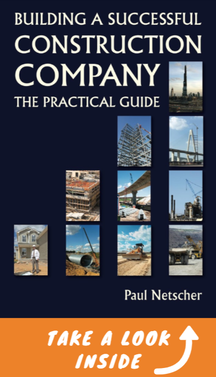 To read more about the author’s books and find out where you can purchase them visit the pages on this website by clicking the links below:
To read more about the author visit the page 'Paul Netscher' Want to contact Paul Netscher please enter your details on 'Contacts' Find out how Paul Netscher can help you  According to the Bureau of Labor Statistics, there are over 15,000 construction site injuries in the US and more than a thousand of those injuries are fatal. Unfortunately, a large number of these injuries could’ve been prevented if the people in charge put some time and effort into quick but effective training sessions and regular reminders. Moreover, during our research, we found that a large portion of these accidents are caused by the presence of heavy machinery on-site, a critical part of almost every construction site, which is why we’ve compiled a list of construction safety tips when working around heavy machinery using data from the BLS, OSHA, and CDC. 1. High Temperatures Heat injury is a serious health problem that affects thousands of workers every year. But combine the extreme heat of the summer with heavy machinery and your construction site becomes a lot more dangerous. Metal surfaces of your machinery can easily burn workers. Your operators are at even greater risk as they might get caught out with hot instruments and lose control of the machine. It’s also not uncommon for operators to fall off a machine due to extremely hot metal surfaces when trying to dismount (more on that later). The best way to avoid such injuries? Protective clothing. Workers might not be too excited about wearing bulky clothes in the heat but it’s for their safety. At the very least, they should be wearing gloves at all times. White-colored clothing, regular breaks, and water would further help in keeping body temperatures down. It’s also in your best interest to know when it’s time to stop. Take a look at OSHA’s Heat Illness Prevention Campaign to learn what temperatures are safe for work. 2. Mounting/Dismounting According to the CDC, falling is the leading cause of work-related injuries and deaths in construction sites, and falls in the construction industry are frequently fatal. In other words, you don't want your workers to lose balance and fall down in an active construction site. The stakes are even higher when there are heavy machinery, like skid loaders, working around them. And what’s the most dangerous and often the most dangerous time to fall? When mounting or dismounting heavy machinery. The best way to avoid such injuries? Use the three-point contact rule, according to which, the worker must maintain at least three points of contact with their hands and feet while mounting or dismounting a machine to limit the possibilities of slipping or falling. 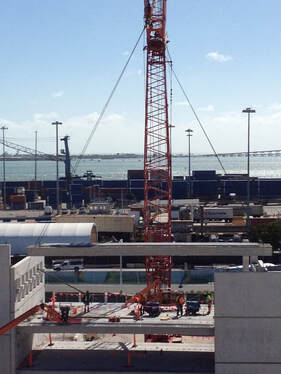 3. Hand Signals As useful and versatile heavy machinery is, they can be noisy and make it difficult when workers try to communicate with one another. In addition, machine operators (especially crane operators) are often positioned far from those directing the work. Not being able to understand each other can have dangerous consequences on a construction site. One way around this is to use radios for communication. It’s also what most construction sites use to overcome loud machines. But radios don’t always work and you must have a backup in case the radios stop working and your operators and workers can’t communicate with each other. The backup? Hand signals. Train employees to learn and use and understand simple but clear hand signals when the need arises. 4. Regular Inspection Machines require maintenance - no two ways about it. But the maintenance also needs to be regular or else critical signs of damage or improper fits can go unnoticed. For instance, if a skid loader’s tracks aren’t properly tensioned, it can simply walk out of its tracks and potentially hurt others nearby. There are millions of other ways a lack of heavy machinery maintenance can lead to disaster in a construction site. So put in the time and effort into keeping your machines in perfect condition. Otherwise, you could be paying $991,027 - the average hospital costs for a fatal construction accident. 5. Training Session A proper training session can be as short as 30-minutes. It would be enough to cover the basics of best safety practices when working around heavy machinery. A few of these training sessions will allow employees to understand the common hazards when working with heavy machinery, the correct way to inspect and maintain heavy machinery, and also teach awareness procedures to both operators and ground crew. And that wraps our top 5 construction safety tips when working around heavy machinery. You can learn about these safety tips through official websites of BLS, OSHA, and CDC.  Nina is a freelance writer specializing in a few niches, including Home & Garden. Writing engaging and high-quality content ranging from interior design and landscape architecture to commercial construction and heavy equipment. Her vice in life is a nice glass of red wine, a great cup of coffee (black), and sandy toes on the beach. Selecting the wrong contractor could be the death of your construction project Have you selected the wrong contractor or subcontractor for your construction project? The contractor performed badly, with delays and poor quality? Perhaps there were hidden extra costs and their final price when the work was complete was much higher than you expected? Regrettably many construction projects go badly because the wrong contractor or subcontractor is selected. Often owners or contractors are only focused on the lowest price and select the cheapest contractor who is sometimes the wrong contractor and proves to be very costly. It’s therefore important to consider the following when selecting your contractor:
....Continue Reading..... This article was first published on the ClockShark website. To visit this website and continue reading the article click on the link above. Please share this post 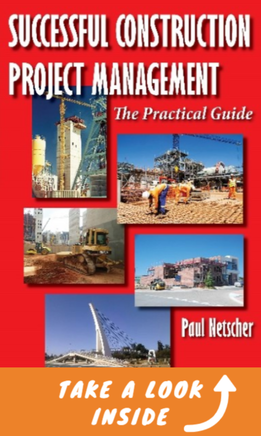 To read more about the author’s books and find out where you can purchase them visit the pages on this website by clicking the links below:
To read more about the author visit the page 'Paul Netscher' Want to contact Paul Netscher please enter your details on 'Contacts' Find out how Paul Netscher can help you Here’s what you need to know about the dust disease affecting construction crews – and it’s not only asbestos  Image courtesy of marin at FreeDigitalPhotos.net Image courtesy of marin at FreeDigitalPhotos.net Most of us know the risks created by asbestos and how asbestos related disease has impacted the health of people around the world. Unfortunately not everyone is aware of the products that contain asbestos, so even now there are scores of people who are inadvertently exposed to asbestos every year. Asbestos was formerly used in many products including insulation, floor coverings, electrical boards, and more. People renovating or demolishing buildings more than 30 years old must take precautions and check to ensure they know what products contain asbestos, and then ensure these are handled and disposed safely. But asbestos isn’t the only silent lung killer. Indeed there are more and more workers in the construction industry being struck down by silicosis. This is caused by breathing in silica dust. Silica dust is created when masons cut materials like concrete, masonry, sandstone and granite. The disease isn’t curable and results in permanent scarring of the lungs. Silicosis is a debilitating disease making even minor physical activity near impossible, and severe cases lead to death. For more read this report. A relatively new source of silica dust is the use of engineered stone kitchen bench tops and bathroom vanity slabs. According to this report engineered stone consists of 90% silica. These tops have to be cut to size and holes are cut and drilled to accommodate the installation of sinks, cook-tops and plumbing fittings. In Australia, where cases of silicosis have increased by 50%, new laws are being introduced to reduce the amount of dust exposure, but these probably don’t go far enough since many workers are exposed to silica dust over prolonged periods of time. In the US, according to a 2015 report from the Centres for Disease Control and Prevention, some 2 million workers are exposed to silica dust, with the highest risks being in mining, quarrying, stonemasons, tunnelling and construction, with many of these workers facing high exposure. Protecting construction workersWorkers need to be aware of the risks of breathing silica dust. Dust should be eliminated by employing cutting and polishing tools which suck the dust up as it’s created. Where possible wet cutting should be done. Workers must wear proper breathing masks. Masks used must be appropriate for the work and most paper masks will not help protect the wearer. Caution must be taken to ensure that people in the vicinity aren’t exposed to the dust. Our health and the health of our workers is important. Don’t take the chance with your life or the lives of others. Contractors who don’t implement the correct safety precautions could be exposed to multi-million dollar lawsuits from those exposed to silicosis on the work-site. Have you been impacted by silicosis? Tell us your story and how it's changed your life. Maybe you know somebody who has silicosis? 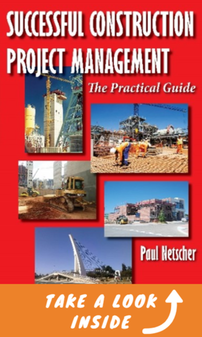 Want to read more construction management tips and insights? Read 'Successful Construction Project Management: The Practical Guide' by Paul Netscher |
Archives
June 2024
Note: We welcome genuine comments, especially comments that add additional information to the subject matter in the article. We however reserve the right to remove inappropriate comments, which includes comments that have nothing to do with the subject, comments that include inappropriate language, and comments that are an advertisement for a product or company, or which include an advertising link. Comments must be in English. We will not enter into discussion on why a particular comment was removed.
CategoriesCopyright 2016 - The attached articles cannot be reproduced for commercial purposes without the consent of the author.
The opinions expressed in the attached articles are those of the writer. It should be noted that projects are varied and different laws and restrictions apply which depend on the location of the contractor and the project. It's important that the reader uses the supplied information taking cognisance of their particular circumstances. The writer assumes no responsibility or liability for any loss of any kind arising from the reader using the information or advice contained herein. "I have what I consider some of the best books on construction management."
Books are available from: Amazon.com Amazon.co.uk takealot.com kalahari.com Amazon.in Amazon.de Amazon.fr Amazon.it Amazon.com.au Powell's Fishpond uread bokus Amazon.ca Amazon.es Other retail stores Available in paperback or on Kindle "28 YEARS OF CONSTRUCTION PROJECT MANAGEMENT EXPERIENCE, DEVELOPING SUCCESSFUL CONSTRUCTION PROJECT MANAGERS AND BUILDING SUCCESSFUL CONSTRUCTION COMPANIES"
|


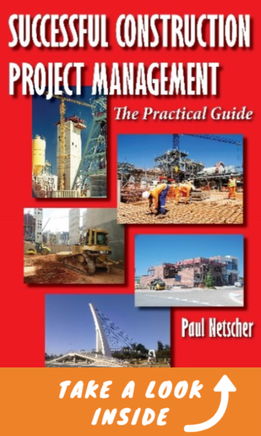


 RSS Feed
RSS Feed




